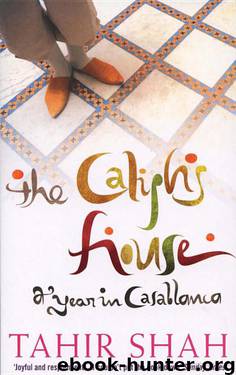The Caliph's House by Tahir Shah

Author:Tahir Shah [Shah, Tahir]
Language: eng
Format: epub, mobi
Tags: General, Pictorials, Travel, nepalifiction, TPB
ISBN: 9781409044796
Google: cI1YJLISo1EC
Amazon: B0045JKERG
Publisher: Random House
Published: 2010-09-28T14:00:00+00:00
There is no such thing as building renovation that runs on time. But I find it hard to believe there has ever been a project more delayed than our own. We continued to camp in one room on the ground floor of what was a large house. The rest of Dar Khalifa was unfit for human habitation, or was downright unsafe.
The architect’s teams had done some passable building work, but they left a wake of destruction and chaos. Despite Kamal’s promises, his master craftsman didn’t turn up until the third week of December. Whenever I asked what had happened to the new team, he enthused that they were led by the maddest, and therefore the most gifted, moualem this side of Marrakech. And, as he declared very frequently, a madman could not be rushed.
The craftsman’s small, ordinary pick-up arrived three days before Christmas. There was a soft scratch at the front door and, a minute later, Hamza was leading the artisan into the house. He was very reserved, with the build of a sumo wrestler, a great hulk of a body poised above a pair of nimble feet. He didn’t look very mad to me.
I drew this point to Kamal’s attention later in the day.
‘Don’t be fooled,’ he said. ‘Aziz is madder than a rabid dog. But he channels his madness into his work.’
I sat for an entire afternoon drinking mint tea, discussing the various types of bejmat and the patterns to be used. A box of tiles was brought out and a handful of samples laid out on the floor. Aziz talked about the colour and consistency of the different clays.
‘This is the red clay from Meknès,’ he said, holding up a square of rose-tinted terracotta. ‘And this is the clay from Fès: much paler, the colour of fresh-baked bread.’
The master’s assistant delved his rough hand into the box again.
‘The bejmat can either be used like this in its raw state,’ Aziz continued, ‘or it can be fired again with one of a hundred glazes – blues, greens, yellows, reds.’ Aziz paused to sip his tea. ‘Until recently,’ he said, ‘unglazed terracotta was not used inside a home. It was considered too crude. But now there is something of a fashion for it.’
The simple terracotta reminded me of Mexico, where haciendas are tiled with them on the inside and roofed with them on the outside. This is no coincidence, of course, as the know-how to make terracotta was transported to the New World by Spanish conqistadores five centuries ago. The Spanish had themselves acquired the techniques from the Moors of Andalucia, who had brought it to Europe from Morocco.
Visit any important building in the kingdom, and you will never see unglazed terracotta used anywhere but on the outside, where it adorns verandas and garden paths. For Rachana and me, there was something very wonderful about it, a stark beauty whose simplicity could be complemented with a scattering of zellij mosaics.
Aziz and his team may have been mad, but they were not stupid.
Download
This site does not store any files on its server. We only index and link to content provided by other sites. Please contact the content providers to delete copyright contents if any and email us, we'll remove relevant links or contents immediately.
1610396766 (N) by Jo Ann Jenkins(1298)
Whatever You Do, Don't Run by Peter Allison(1246)
Botswana--Culture Smart! by Michael Main(1238)
In Arabian Nights by Tahir Shah(1199)
Livingstone by Tim Jeal(1152)
The Old Farmer's Almanac 2020 by Old Farmer’s Almanac(1152)
Ubuntu by Ellis Heather;(1136)
The Templars by Michael Haag(1125)
Dead Eye by Mark Greaney(1106)
Africa: Altered States, Ordinary Miracles by Richard Dowden(1078)
Top 10 Israel and Petra by DK Travel(1070)
Morocco Travel Guide by Lonely Planet(1065)
Egypt Travel Guide by Lonely Planet(1055)
The Promise of a Pencil: How an Ordinary Person Can Create Extraordinary Change by Braun Adam(1055)
False Papers by André Aciman(1050)
First Comes Love, then Comes Malaria by Eve Brown-Waite(1042)
Jeff Corwin by Jeff Corwin(1030)
The Masked Rider by Neil Peart(987)
African Nights by Kuki Gallmann(966)
